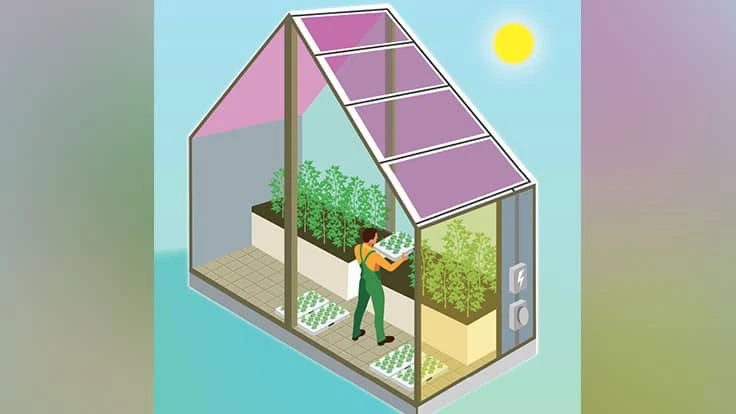

Engineering, plant biology and physics researchers at North Carolina State University are looking at ways greenhouses could become energy neutral by using see-through solar panels to harvest energy. In a recent study, "Achieving Net Zero Energy Greenhouses by Integrating Semitransparent Organic Solar Cells," researchers looked at the benefits of using semitransparent organic cells to mitigate energy consumption.
Brendan O’Connor, corresponding author of the study and an associate professor of mechanical and aerospace engineering at NCSU, says the research aimed to see if the energy demand of a greenhouse could be met by placing semitransparent solar cells on its roof.
O’Connor credits the effort to a “serendipitous discussion” between himself and colleagues. “We were in a meeting discussing energy in general and someone said, ‘Look, these organic solar cells have an absorption spectrum that could potentially compliment chlorophyll absorption.’’’
This led to ongoing experiments to assess plant growth under solar cells, the synthesis of new materials to tune absorption spectrums, and the impact of different solar-cell material on plant growth. According to O’Connor, plants only use some wavelengths of light for photosynthesis and the idea of the study was to create a greenhouse that makes energy from the unused light while simultaneously allowing most of the photosynthetic band of light to pass through.
For the study, O’Connor and his colleagues used a model to determine how much energy greenhouses in Arizona, North Carolina and Wisconsin could produce with semitransparent organic solar cells on their roofs, and if the amount was enough for the greenhouses to operate effectively.
While the data has not been published nor publicized yet, O’Connor says, “it looks very promising” and that he and the research team are excited about it.

“I think greenhouses are going to continually get more sophisticated with technology, and I think that our solar cells in general are going to be part of that solution,” he says. “As they get more sophisticated and are able to be more energy independent, then it's only going to help productivity and help economics and hopefully continue to improve implementation widespread for a range of plants.”
Since the model is funded by the National Science Foundation under the intersection of food, energy and water systems, it focuses on tomato growth.
“We’re trying to do this for common food crops,” O’Connor says, “and the goal of that grant is to look at food production, energy consumption, water usage and how those things intersect and how they can be improved for future agricultural purposes. Since we're looking at agriculture and food production specifically, we want to look at crops for food instead of [studying] flowers and ornamentals, and since tomatoes are a very common greenhouse crop, it was sort of an obvious choice for us.”
While tomatoes serve as a starting point, O’Connor says the researchers are also looking at other potential crops like lettuce and cucumbers, and high-value crops like herbs.
Since the study is still at research level, however, things like price and ease of installation are still being worked out. But O’Connor says the panels used for the models work as insulators because they reflect infrared light, which can help reduce greenhouse overheating and trap warmth in the winter, “which may make financial sense to growers.” As for setup, he foresees a manageable one. “We envision it to be a really simple installation that would not require any sort of new greenhouse structure and no additional supports. In theory, it could hopefully be kind of plug and play: unroll and plug it in. And while it won’t be that simple, we’ll try to make it as close to that as we can so it’s that type of strategy.”
Overall, O’Connor and his team aim to make a major contribution to science and crop production with their study. “We really hope that it gets widely adopted and it's a win-win for not only greenhouses, but the solar cells as well,” he says. “We hope that there's a wide adoption. In organic solar cells, there's several startups and there's some products, but they're really limited almost to the point of just demonstration and smaller things. They're not widely sold. So, we hope that this really improves the market for organic solar cells. Also, if we can improve the energy balance, maybe we can lower the environmental footprint of greenhouses, which becomes more economically viable and a greener way to do agriculture.”

Explore the May 2020 Issue
Check out more from this issue and find your next story to read.
Latest from Greenhouse Management
- North Carolina Nursery & Landscape Association announces new executive vice president
- Plant Development Services, Inc. unveils plant varieties debuting in 2025
- Promo kit available to celebrate first National Wave Day on May 3
- Applications now open for American Floral Endowment graduate scholarships
- Endless Summer Hydrangeas celebrates 20 years with community plantings
- Invest in silver
- Garden Center magazine announces dates for 2025 Garden Center Conference & Expo
- USDA launches $2 billion in aid for floriculture growers





